- Home
- William H. Keith
Symbionts Page 20
Symbionts Read online
Page 20
“Chikusho!” he snapped, the curse hard and violent. Savagely, he opened a tactical link to the Imperial freighters still in orbit around ShraRish. “Blue Peacocks! Blue Peacocks. This is Red Sword. The battle here is lost. Save yourselves, any way you can. I suggest you break orbit at once, get to a safe distance, then return to Earth orbit and rendezvous with the First Fleet. Hattori out!”
He didn’t bother waiting for a reply. Instead, he shifted channels to Naginata’s internal communications and ordered the destroyer’s captain to engage full acceleration.
Naginata’s drive plumes exploded astern, dazzling suns driving the destroyer forward under a full 6 Gs. Bits and pieces of debris—fragments of exploded missiles or the blast-shredded remnants of hull armor torn from starships—thumped and clattered along her slender, heavily armored prow. The Confederation carrier flashed past fifteen thousand kilometers to starboard, but Hattori ordered the Naginata’s weapons officer to ignore it. The destroyer had already expended over three quarters of the missiles aboard, and he wanted to preserve them against the possibility of ambush later. Eagle passed seconds later, close by the Confederation transport.
Then they were safely out of range, heading for deep space. At Hattori’s command, the ship’s quantum power tap was engaged, then the ship was translated into the blue flame of K-T space.
He would decide just where it was they were fleeing to later.
Within the victorious Confederation squadron, damage control measures were under way as personnel fought to save the damaged ships. Constellation had taken some serious hits but was not in immediate danger. Valiant was in a much more serious way; her exchange with the Asagiri had savaged her RM storage tanks and forced an automatic scram on both her fusion plants and her QPT, leaving her powerless, a drifting hulk.
Corvettes and frigates, the low end of the mass-ordered hierarchy of starfaring warships, were hybrids. Originally designed as small, in-system escorts and patrol craft, they massed from one to five thousand tons and were powered solely by the compact fusion plants that converted slush hydrogen to plasma—simple fusion rockets incapable of traveling from one star system to another in anything less than decades.
As Hegemony and Empire had spread through the nearer stars, however, it had been discovered that small warships, massing a thousand tons or so and with crews of 150 or less, were far more efficient at patrol duties than the light destroyers, the smallest of which were 250 meters long and massed over forty thousand tons. The reason for their enormous size, of course, was the quantum power tap arrays necessary both for channeling energy from the Quantum Sea and for prying open the fabric of normal fourspace that let the starship slip into the Kamisama no Taiyo, the “Ocean of God” where jacker-oriented maneuvers allowed the ship to bypass space, effectively traveling three to four hundred times faster than light. The smallest power tap, complete with the field generators and shielding needed to call two mutually orbiting microsingularities into existence, hold them in finely focused harmonic tuning, and channel the cascade of energy they released across the quantum barrier, required a structure the size of a skyscraper and massing forty thousand tons or more.
The answer was to build drive modules—more popularly called skip riders—forty- to fifty-thousand-ton constructs that housed QPT and drive arrays, fusion plants, plasma thrusters, and reaction mass tankage enough to fuel the thing. The relatively tiny corvette or frigate rode perched atop the whole assembly like the upper stage of one of the clumsy, multistage rockets of the pre-fusion era of spaceflight. Using the skip rider, a frigate could make the K-T passage to another star. Once there, it could park its drive module in some convenient orbit and carry out its assigned deployment, a shark instead of a whale.
Asagiri’s barrage had gutted Valiant’s drive module, leaving it a twisted tower of wreckage, half-melted and dangerously radioactive. Her crew was now hard at work attempting to release the frigate from the deadweight of its skip rider. Unfortunately, the magnetic clamps that secured the ship to the drive module had been frozen shut by the module’s power failure. Rebel, braving the radiation leaking from Valiant’s dangerously hot carcass, was rendering assistance, but it was too early yet to tell whether Valiant could be freed from the deadly embrace.
The rest of the Confederation ships had begun decelerating toward ShraRish orbit.
Slowly, slowly, Dev came down from the high-tide storm of emotion that had burst through him during the battle. God… he was shaking, or he would be, as soon as he broke his linkage and stepped out of the ViRcom module. He could feel that telltale tremulousness, the weakness that made him wonder whether he would even be able to stand once he was out of linkage.
The battle was over. One of the Imperial destroyers, by accelerating right through the Confederation deployment, had put itself out of reach and minutes later had translated into K-T space. At ShraRish, the freighters were scattering like sheep as the warflyer wolves descended on them. Most would probably escape; with luck, the fighters might cripple one or two. Their cargoes would be welcome additions to Farstar’s inventory of expendables.
Carefully, Dev downloaded the command that would break him out of linkage, then executed the withdrawal.
Nothing happened.
Startled, Dev stared at his surroundings… still the tactical simulation showing the Confederation fleet and, ahead, the tiny gold orb of ShraRish. Something had gone wrong; he’d tried to disconnect and failed. There was no way that could have happened. The AI feed, his own cephlink, and the programs that ran the simulation, all were designed to boot him clear of the hookup should there be a major failure in any system.
What had gone wrong?
Again, with an almost exaggerated deliberation, he downloaded the disconnect codes, then initiated the withdrawal sequence. There was a terrifying moment of emptiness…
… and then he was back in his physical body, lying inside the ViRcom module. Quickly, he slapped the release that freed the life-support tubes from his shipsuit and thumbed the control that dissolved an accessway through the module’s side. Light spilled in from outside and he blinked; tears blurred his eyes.
Oh, God! What happened there? He took a moment to pull a diagnostic log on his cephlink’s processor. Yes… the correct command had been issued. A fault in Eagle’s AI, or in the module hardware? The gleaming constellation of green lights on the module’s panel said all was well on that end. He reran the diagnostic, tracing the scrolling lines of data flickering through his awareness farther. There! A subroutine in his own link hardware had blocked the link termination protocol before transmission to the module. He froze the mental display and stared at the data accusingly. That should not, could not have happened. He had, in effect, unconsciously stopped his own coded order to Eagle’s AI to disconnect.
Clearing the display from his mind, he opened his eyes, unjacked his helmet feeds, then slipped off his helmet and stowed it in its recess. Stepping out of the module, he found the deck with his feet. He felt… strange, light-headed, a little dizzy.
Nausea rose up unexpectedly, gagging him, taking him by surprise. He vomited onto the deck, then nearly fell as the weakness swept through his body.
Unaccountably, he found himself wanting to crawl back inside the module, to jack in and lose himself again in the glorious emptiness of space. He hurt… and he felt so weak he could scarcely stand.
Supporting himself with one hand against the module, he looked up. Katya was there, looking at him with mingled fear and concern. He remembered her trying to get through to him, remembered ignoring her. There’d been nothing deliberate in that, he recalled. She simply hadn’t mattered.
He swallowed, the taste acid-hot and bitter.
Something was very seriously wrong with him, and he had to find out what it was.
Chapter 18
Where earlier advances in communications and electronics represented obvious progress in Man’s technical evolution, the development of cephlink technology represented a leap greater
than those earlier developments by many orders of magnitude. Where earlier advances might be compared to the biological evolution of the eye, say, or of chordate anatomy, the cephlink could be compared to one of those unforeseen shifts in evolutionary direction that created whole new universes for life to exploit—comparable, say, to the colonization of the land, or the invention of sex. Many today accept human-cephlink cyborgs as an entirely new order of creature, as distinct from homo sapiens as the amphibian is from the fish and with the same, greater evolutionary promise.
—The Rise of Technic Man
Fujiwara Naramoro
C.E. 2535
Seen from orbit, ShraRish was exactly as Katya remembered it. Like Dev, she’d last orbited the world aboard the transport Yuduki, one of the armada of Hegemony and Imperial ships that had visited the twin Alyan system back in 2541. Its small oceans and landlocked seas gleamed purple beneath the blaze of Alya A, while the land was covered in vegetation that overall looked gold, but which when examined closely showed a beautiful mottling of orange, brown, ocher, yellow, red, and pink.
And the mountains. She’d forgotten the mountains. Three billion years younger than Earth, ShraRish was more tectonically active by far than that relatively placid and middle-aged world. From orbit, the largest ranges looked like wrinklings in the skin of overripe fruit; active volcanos were marked by thousand-kilometer plumes of gray-brown smoke and ash, while on the planet’s night hemisphere the eruptions showed as sullen red pinpoints wreathed in the silent throb and pulse of lightning storms. The nightside, too, was brought alive by the planet’s auroral displays and meteor falls. With a more active, energetic sun than Earth, the darkness-shrouded portions of the polar areas of this world were always crowned by pale, shifting circlets of light, while a sharp eye could discern the steady flicker and streak of meteors vaporizing as they struck atmosphere.
Two hours earlier, Eagle had entered low orbit around ShraRish and her hab modules had been set to rotating, providing a half G of spin-gravity. Valiant and Rebel were still en route; the frigate had finally been freed from the wreckage of her drive module by surgically directed laser bursts from the corvette and was now being brought in under tow. The rest of the squadron was with Eagle in orbit, as the widely scattered fighters of the 1st Wing continued to straggle in. Mirach and the Confederation freighters were inbound from their vantage point at the frontiers of the Alyan system.
The entire squadron was still on full alert, but unless the enemy had more ships hidden somewhere with reactors scrammed and power sources shut down, it looked as though the Confederation now controlled near-ShraRish space. Two Imperial freighters had been caught by Tarazed’s warflyers before they could break orbit. The others, together with the lone surviving Imperial destroyer, had made the translation to K-T space and were long gone, almost certainly on their way back to the Shichiju.
There’d been no response, so far, from the Imperial forces on the surface of ShraRish.
* * *
Katya had joined Dev in Eagle’s lounge, where he’d taken a seat on a low sofa bordering a sunken area in the middle of the room, while she stood before him, hands on hips. She was furious at him, more angry, if that was possible, than she’d been when Sinclair had given her the order to leave New America.
“Just what the hell is the matter with you, Dev?” she demanded, ignoring the white, gold, and violet panorama on the lounge viewall behind the sofa. Set to display the planet’s surface as seen from a camera mounted on Eagle’s bow, the screen revealed no movement save the steady, silent glide of clouds, seas and mountains over the curve of the planet.
“Nothing,” Dev replied. “I told you, nothing! I’m fine!”
“You get sick all over the deck coming out of link, you can hardly stand up, and you tell me you’re fine?”
He looked a little better now than when she’d met him by the link module. She’d slap-injected him with medical nano, then helped him back into the module, jacked him in, and summoned a med-psych monitor on the link.
“It’s okay, Kat. I’m okay. Don’t make more of it than it is.”
“That, Dev, sounds like a classic case of denial. I don’t want to hear what you think. What did the monitor program say? Or do I have to haul you down and let the nanosomatic engineers take you apart?”
“My physiodiagnostics still check okay,” he told her. “I’m a little… depressed, is all.”
“Depressed? Depressed? Depression doesn’t make people vomit. And it doesn’t turn people as close as we’ve been into strangers.”
He sighed. “Hate to tell you, Kat, but you’re wrong. It does all that, and more.”
“Did the monitor suggest treatment?”
He nodded. “It prescribed a series of sex and relaxation ViRsims, and a daily, five-minute series of in-link alpha modulations. Tranquilizers, in other words.”
“Okay. Fine. Are you doing it?”
He gave a half smile. “I’ve hardly had time to, have I? Anyway, I… I don’t think I really want to.”
“Why the hell not?”
“Because I’m more than halfway convinced that linking is my problem.”
Katya felt herself go cold. “What, you think you’re going null? That’s ridiculous, Dev, and you know it.”
Nulls were those people who, for physiological, psychological, religious, or ethical reasons could not accept the nano-grown cephlink hardware that allowed them to interact with technic society. They formed a substantial, if largely invisible, minority throughout both the Core and Frontier of the Shichiju.
“No, I’m not going null. Quite the opposite, in fact. I… think I’m in some kind of withdrawal.”
Katya looked for the right words to say, then failed. Withdrawal? She knew whatever Dev was going through had to be wrapped up in his experience with the Xenolink, since he’d never had any real trouble with linkage one way or the other before. He’d always shown a slight tendency toward technomegalomania, enough, she remembered, to get him disqualified for the Hegemony Navy, but except for an occasional touch of recklessness, it had never seemed to affect him.
What had changed?
At that moment, several off-duty engineers entered the lounge. Katya didn’t want to discuss something so personal as this in public, especially something that could erode the confidence the squadron’s personnel felt in their military CO if it got around.
Dev was obviously thinking the same thing. “Well, Katya,” he said rising from the sofa, “I’d better get back to work. Want to be linked in when Rebel hauls the Valiant into orbit. I’ll talk to you more about it later, if you want. I assure you, though, that there’s nothing wrong. Later?”
“At dinner,” she told him. “Officers’ mess.”
“At dinner.” He walked out, leaving her alone by the viewall.
But he wasn’t at dinner. When she inquired through Eagle’s AI network, she learned he was in a tactical sim, overseeing the beginnings of the repair work to both Constellation and Valiant. She left word for Dev that she would be in the lounge, then returned there to find a seat in front of the viewall.
The compartment was fairly crowded when she got there. Brenda Ortiz was there, along with several of the scientists and programmer techs from the expedition’s contact team.
She stood before the viewall for a time, watching the drift of ShraRish’s seas and clouds. In the distance, an odd assembly of bulky, angular shapes gleamed in the sunlight. Frigates were, by ship-class definition, larger than corvettes, but Rebel was still wearing her skip rider, and the dismounted Valiant looked like a toy clutched tightly against the other ship’s belly.
Was Dev really addicted to linkage? She’d heard of such things happening, of course, though usually it involved some poor guy—or gal—wiring into a continuous orgasm loop and burning out the pleasure centers. Such people weren’t good for much after that, not without a massive neural rewrite, a reprogramming of memory and personality that amounted to wiping the brain clean and starting over.<
br />
She shuddered, preferring not to think about that. Whatever was haunting Dev was nothing so obvious as sex addiction. He’d mentioned being depressed, but this was more subtle than TDS, or technodepressive syndrome. He could still function and didn’t seem impaired in any way.
But how would it affect his performance as the squadron’s commanding officer? If he had to be relieved, Lisa Canady would replace him, and while Katya had nothing specific against her, the woman was still something of an unknown quantity.
Maybe, she told herself, it’s none of your business. Go back to the Trixie, see to your troops, and get ready for the landings. You’re going to have enough to worry about without wondering what’s going on in Dev’s scrambled brains.
But she couldn’t just walk away from him. She had to help. But how?
“It’s beautiful, isn’t it?”
Katya started. Brenda Ortiz stood at her side, a glass of caff in her hand. She was staring at the viewall display, where the curved horizon of ShraRish bowed against the tiny, blazing disk of Alya A. Eagle was past the planet’s terminator and falling into night.
“It makes you wonder,” Brenda continued, “just how accurate our notions of our own planet’s history really are.”
“What do you mean?”
Brenda nodded toward the planet below. “Everything we’ve learned about that ecosystem has been teaching us more about our own. And about life in general. It turns out that the evolution of life isn’t quite so unlikely as we always thought.”

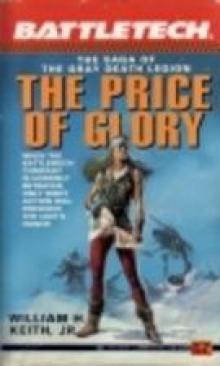 The Price of Glory
The Price of Glory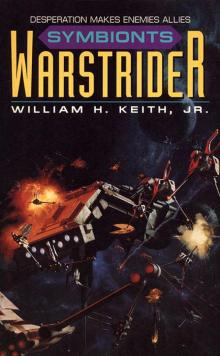 Symbionts
Symbionts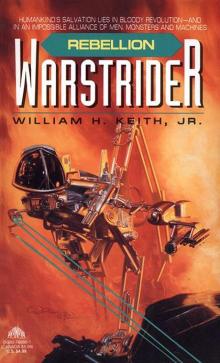 Rebellion
Rebellion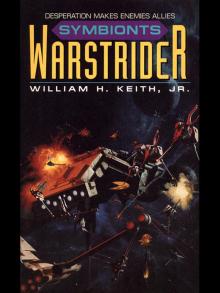 Warstrider 04 - Symbionts
Warstrider 04 - Symbionts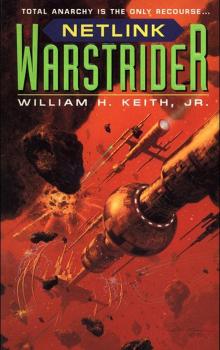 Netlink
Netlink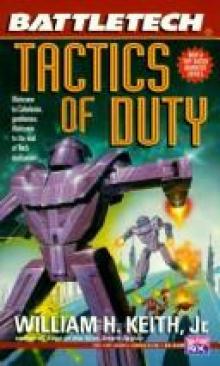 Tactics of Duty
Tactics of Duty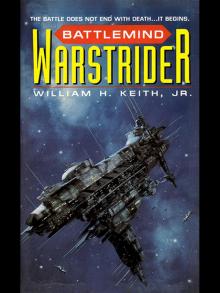 Warstrider 06 - Battlemind
Warstrider 06 - Battlemind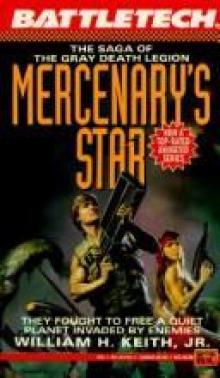 Mercenary's Star
Mercenary's Star Battlemind
Battlemind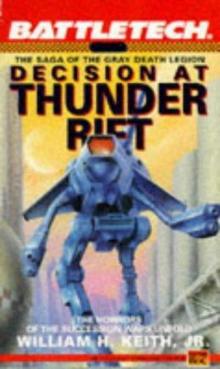 Decision at Thunder Rift
Decision at Thunder Rift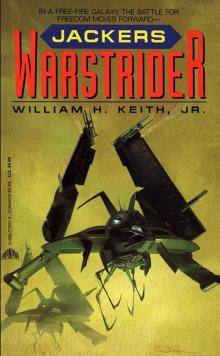 Jackers
Jackers Android: Free Fall
Android: Free Fall Warstrider 01 - Warstrider
Warstrider 01 - Warstrider Warstrider 05 - Netlink
Warstrider 05 - Netlink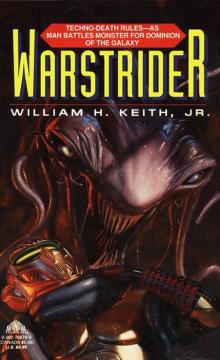 Warstrider
Warstrider